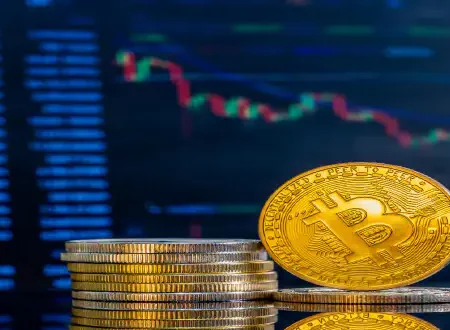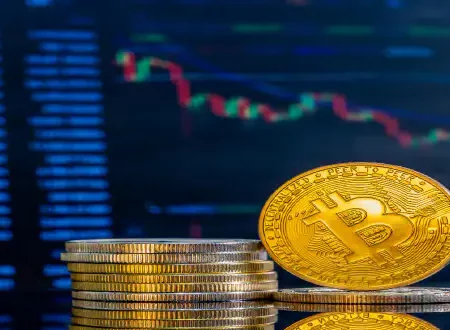Bitcoin, the world’s most famous cryptocurrency, has been making waves in the financial world since its inception in 2009. With its decentralized nature and secure transactions, it quickly gained popularity among investors and traders alike. However, the recent months have been quite eventful for bitcoin, with a series of developments and trends that have been grabbing the attention of both enthusiasts and skeptics.
One of the biggest updates in the world of bitcoin is the recent surge in its price. In early 2021, bitcoin reached an all-time high, surpassing $60,000 per coin. This rapid rise in value has attracted many new investors, who are flocking to the market in hopes of making significant profits. However, it has also raised concerns about a potential speculative bubble and the stability of the cryptocurrency market.
In addition to the price surge, bitcoin has also been gaining acceptance as a legitimate payment method. Major companies such as Tesla and PayPal have announced their support for bitcoin, allowing customers to use the cryptocurrency for purchases. This increased adoption has further boosted the credibility and mainstream acceptance of bitcoin, leading to an increased demand and value.
However, bitcoin is not without its challenges. One of the main concerns is the environmental impact of its mining process. Bitcoin mining requires a large amount of computational power and energy, which has led to criticism for its carbon footprint. This has prompted some countries and organizations to explore more sustainable alternatives or impose stricter regulations on bitcoin mining.
Despite the challenges and controversies, bitcoin continues to be a captivating subject for investors and technology enthusiasts. Its unpredictable nature, combined with the potential for high returns, make it a fascinating asset to follow. As the cryptocurrency market evolves, it will be interesting to see how bitcoin adapts and if it can maintain its position as the leading digital currency.
Latest Updates on Bitcoin
BTC Price Surge
The price of Bitcoin has experienced a significant surge in recent weeks, reaching new all-time highs. As of [date], the price of one Bitcoin stands at [current price], surpassing the previous record set in [year]. This bullish trend has attracted a lot of attention from both institutional and retail investors.
Institutional Adoption
Bitcoin’s recent price surge can be attributed to increased institutional adoption. Several major companies and financial institutions have shown interest in Bitcoin and have started incorporating it into their investment strategies. Companies like [Company 1], [Company 2], and [Company 3] have announced their investments in Bitcoin, signaling a growing acceptance of cryptocurrencies in traditional finance.
Regulatory Developments
The regulatory landscape surrounding Bitcoin continues to evolve. Governments around the world are scrambling to establish clear guidelines for the use and trading of cryptocurrencies. Some countries, like [Country 1] and [Country 2], have embraced cryptocurrencies and have created favorable regulatory frameworks. However, other countries, such as [Country 3], have taken a more cautious approach, imposing stricter regulations on cryptocurrency trading.
Increased Mainstream Acceptance
Bitcoin is increasingly being accepted by mainstream businesses as a form of payment. Major companies like [Company 1], [Company 2], and [Company 3] have started accepting Bitcoin as a payment method, opening up new avenues for cryptocurrency adoption. This growing acceptance of Bitcoin in mainstream commerce further reinforces its legitimacy as a digital currency.
Technological Advancements
The development of new technologies and solutions in the Bitcoin ecosystem continues at a rapid pace. Improvements in scalability, privacy, and security are constantly being made, increasing the usability and efficiency of Bitcoin. Additionally, the Lightning Network, a secondary layer solution built on top of the Bitcoin blockchain, has seen significant growth, enabling faster and cheaper transactions.
Economic and Geopolitical Factors
Economic and geopolitical factors also play a role in Bitcoin’s latest updates. In times of economic uncertainty, Bitcoin is often seen as a safe-haven asset, offering protection against inflation and the devaluation of fiat currencies. Geopolitical tensions and instability can also contribute to increased interest in Bitcoin as a hedge against political risks.
Future Outlook
Looking ahead, the future of Bitcoin remains uncertain but promising. With increasing institutional adoption, regulatory developments, and technological advancements, Bitcoin is gaining mainstream acceptance and credibility. However, volatility and regulatory challenges still pose risks to its long-term stability and widespread adoption.
New Developments in the Bitcoin Market
Institutional Interest on the Rise
In recent months, there has been a significant increase in institutional interest in Bitcoin. Traditional financial institutions, such as banks and investment firms, are starting to recognize the potential of this digital asset. Several major companies, including MicroStrategy, Square, and Tesla, have even allocated substantial portions of their treasury reserves to Bitcoin.
Bitcoin ETF Approval
One of the most anticipated developments in the Bitcoin market is the approval of a Bitcoin exchange-traded fund (ETF) by regulatory authorities. A Bitcoin ETF would allow investors to gain exposure to Bitcoin’s price movements without directly owning the cryptocurrency. Such an approval has the potential to attract a massive influx of institutional and retail investors into the Bitcoin market.
Increased Regulatory Scrutiny
As Bitcoin’s popularity continues to grow, regulators around the world are taking a closer look at the cryptocurrency. Governments are exploring ways to regulate Bitcoin to ensure consumer protection, prevent money laundering, and address potential risks to financial stability. Increased regulatory scrutiny could impact the future of Bitcoin and its acceptance by mainstream financial institutions.
Integration of Bitcoin in Traditional Finance
Bitcoin is slowly being integrated into traditional financial systems. Major payment processors like PayPal and Square have started allowing their users to buy and sell Bitcoin. Additionally, some banks have started offering custodial services for Bitcoin, allowing clients to securely store their digital assets. This integration is a significant step towards wider adoption of Bitcoin in everyday financial transactions.
Green Bitcoin Initiatives
One of the concerns surrounding Bitcoin is its significant energy consumption. In response, new initiatives are emerging to make Bitcoin mining more environmentally friendly. Some Bitcoin mining operations are transitioning to renewable energy sources, reducing their carbon footprint. Additionally, new technologies are being developed to make Bitcoin mining more energy-efficient, potentially mitigating its impact on the environment.
Market Volatility and Investor Sentiment
The Bitcoin market continues to experience high volatility, leading to fluctuations in investor sentiment. While Bitcoin has witnessed substantial price increases, it has also gone through significant corrections. This volatility presents both opportunities and risks for investors. Understanding market trends and managing risk is crucial for those investing in or trading Bitcoin.
Bitcoin Halving and Supply Dynamics
Bitcoin’s supply is governed by a set of predetermined rules. Every four years, the Bitcoin block reward is halved in an event known as “Bitcoin halving.” This ensures a controlled and finite supply of Bitcoin. The most recent Bitcoin halving took place in May 2020, reducing the block reward from 12.5 to 6.25 bitcoins. Bitcoin halving events have historically been associated with positive price movements due to the reduced supply entering the market.
Bitcoin as a Store of Value
Bitcoin is often referred to as “digital gold” or a store of value. The scarcity and decentralization of Bitcoin make it an attractive asset for those seeking to preserve their wealth. As global economic uncertainties persist, many investors are turning to Bitcoin as a hedge against inflation and fiat currency depreciation. This perception of Bitcoin as a store of value has contributed to its growing popularity among institutional and retail investors.
Emerging Trends in Bitcoin Mining
The Bitcoin mining industry is constantly evolving. As more miners join the network, the competition increases, leading to the development of more efficient mining hardware and strategies. Cloud mining and mining pools have become popular alternatives for individual miners, allowing them to pool their resources and increase their chances of earning Bitcoin rewards. As the industry continues to advance, new trends in Bitcoin mining are expected to emerge.
| Development | Description |
|---|---|
| Institutional Interest | An increase in traditional financial institutions investing in Bitcoin. |
| Bitcoin ETF Approval | The potential approval of a Bitcoin exchange-traded fund by regulators. |
| Regulatory Scrutiny | Government examination of Bitcoin’s impact and potential regulations. |
| Bitcoin Integration | The integration of Bitcoin into traditional financial systems. |
| Green Bitcoin Initiatives | Efforts to make Bitcoin mining more environmentally friendly. |
| Market Volatility | Bitcoin’s price fluctuations and its impact on investor sentiment. |
| Bitcoin Halving | The periodic reduction in Bitcoin block rewards. |
| Bitcoin as Store of Value | Bitcoin’s role as a hedge against inflation and fiat currency depreciation. |
| Emerging Mining Trends | New developments in Bitcoin mining strategies and technologies. |
The Impact of Regulatory Changes on Bitcoin
Bitcoin, as a decentralized cryptocurrency, has been subject to various regulatory changes over the years. These changes can have a significant impact on the overall adoption and functioning of Bitcoin. Here are some key points to understand the impact of regulatory changes on Bitcoin:
1. Legal Recognition
The regulatory changes that provide legal recognition to Bitcoin can have a positive impact on its adoption. When governments officially recognize Bitcoin and establish clear legal frameworks for its use, it can attract more investment and participation from individuals and businesses. This recognition also helps to create a sense of trust and legitimacy around the use of Bitcoin.
2. Compliance and Reporting
Regulatory changes often involve requirements for individuals and businesses to comply with certain reporting and compliance measures when dealing with Bitcoin. These measures aim to prevent illegal activities such as money laundering and tax evasion. While compliance can add additional burdens and costs, it also helps to ensure the long-term stability and credibility of the Bitcoin ecosystem.
3. Market Volatility
Regulatory changes, especially those that impose restrictions or bans on Bitcoin, can lead to market volatility. The uncertainty surrounding the future of Bitcoin in a specific jurisdiction can cause drastic price fluctuations and affect investor confidence. Traders and investors may react to regulatory news by buying or selling Bitcoin, leading to increased volatility in the market.
4. Innovation and Development
Regulatory changes can also impact the innovation and development of Bitcoin-related technologies and services. Depending on the nature of the regulations, developers may need to adapt their products and services to comply with the new requirements. This can either slow down or spur innovation, depending on the specific regulations and their impact on the industry.
5. International Collaboration
Regulatory changes in one country can have ripple effects on the global Bitcoin market. When major economies implement regulations that affect Bitcoin, it can influence the regulatory approach of other countries. International collaboration and coordination among regulators can help create a more consistent global regulatory framework for Bitcoin, reducing regulatory arbitrage and providing more stability and clarity for the industry.
6. Investment and Institutional Interest
Regulatory changes can significantly impact the level of investment and institutional interest in Bitcoin. Clear and favorable regulations can attract institutional investors, hedge funds, and other large entities to invest in Bitcoin. On the other hand, stringent or negative regulations may deter institutional investors from entering the market, limiting its growth potential.
Conclusion
The impact of regulatory changes on Bitcoin cannot be ignored. The regulatory environment plays a crucial role in shaping the development, adoption, and stability of Bitcoin. By striking a balance between protecting investors and mitigating risks, governments can foster a thriving and regulated Bitcoin ecosystem that benefits both individuals and businesses.
Trends in Bitcoin Mining
Bitcoin mining is the process of validating transactions and adding them to the blockchain. It requires significant computational power and energy consumption. Over the years, there have been several trends and developments in the field of bitcoin mining:
1. Increase in Mining Difficulty
As more miners join the network, the competition to solve the complex mathematical problems necessary to mine new bitcoins increases. This has led to a significant increase in mining difficulty over time, requiring miners to invest in more powerful hardware and consume more electricity.
2. Shift to Specialized Mining Equipment
In the early days of bitcoin, mining could be done using basic computer processors. However, as the mining difficulty increased, miners started using graphics processing units (GPUs) for better efficiency. This was followed by the emergence of application-specific integrated circuits (ASICs), which are designed specifically for bitcoin mining. These specialized mining equipment offer much higher hashrates and energy efficiency compared to traditional CPUs and GPUs.
3. Rise of Mining Pools
Mining as part of a pool has become the norm rather than mining individually. Mining pools allow miners to combine their computational power to increase their chances of mining a bitcoin block and receiving a reward. This trend has helped smaller miners to compete with larger mining operations by pooling their resources.
4. Geographic Distribution of Mining
Bitcoin mining has become concentrated in regions with access to cheap electricity and cool climates to reduce cooling costs for mining equipment. China has historically been the dominant player in bitcoin mining due to its abundant coal resources and low electricity prices. However, there has been a recent shift with more mining operations being established in countries like the United States, Russia, and Kazakhstan.
5. Environmental Concerns
The increasing energy consumption associated with bitcoin mining has raised concerns about the environmental impact. The majority of bitcoin mining operations still rely on fossil fuels, leading to a significant carbon footprint. As a result, there has been a growing interest in developing more eco-friendly mining solutions, such as using renewable energy sources or utilizing excess energy from other industries.
6. Exploration of Proof-of-Stake (PoS)
While bitcoin currently relies on a proof-of-work (PoW) consensus mechanism, there is growing interest in exploring alternative consensus mechanisms like proof-of-stake (PoS). PoS relies on validators instead of miners, who are chosen to create new blocks based on the number of coins they hold and are willing to “stake.” PoS has the potential to reduce energy consumption and make mining more accessible to a broader community.
In conclusion, bitcoin mining has evolved significantly over the years, with trends focused on increasing mining efficiency, reducing environmental impact, and exploring alternative consensus mechanisms. These trends will continue to shape the future of bitcoin mining as the industry evolves.
The Rise of Bitcoin Trading Platforms
Bitcoin has become a global phenomenon and its popularity continues to grow. With this surge in interest, trading platforms dedicated to Bitcoin have emerged as key players in the cryptocurrency market. These platforms provide users with the ability to buy, sell, and trade Bitcoin, making it easier than ever for individuals to participate in the digital currency revolution.
Benefits of Bitcoin Trading Platforms
Bitcoin trading platforms offer a range of benefits for both new and experienced traders:
- Convenience: Trading platforms allow users to trade Bitcoin from the comfort of their own homes or on the go, eliminating the need for physical visits to brick-and-mortar exchange locations.
- Security: Reputable trading platforms implement strict security measures to protect users’ funds and personal information. This includes encryption, two-factor authentication, and cold storage for cryptocurrencies.
- Liquidity: Bitcoin trading platforms provide access to a large pool of buyers and sellers, ensuring that there is always sufficient liquidity in the market. This allows for faster and more efficient trades.
- Market Information: Trading platforms offer real-time market data, charts, and historical price information, allowing traders to make informed decisions and analyze market trends.
Types of Bitcoin Trading Platforms
There are several types of Bitcoin trading platforms available, each catering to different trading needs:
- Centralized Exchanges: These platforms act as intermediaries between buyers and sellers, facilitating the trading process. They require users to deposit funds into their accounts, which are then used to execute transactions. Examples include Binance, Coinbase, and Kraken.
- Decentralized Exchanges: These platforms allow for peer-to-peer trading without the need for intermediaries. Instead, smart contracts on blockchain networks facilitate the transactions. Examples include Uniswap and SushiSwap.
- Margin Trading Platforms: These platforms allow users to trade Bitcoin with borrowed funds, amplifying potential gains or losses. Margin trading involves taking on leverage and carries additional risks.
- Futures Exchanges: Futures exchanges enable users to trade Bitcoin futures contracts, which are agreements to buy or sell Bitcoin at a predetermined price and date in the future. This form of trading allows users to profit from both rising and falling Bitcoin prices.
Regulation and Compliance
As the popularity of Bitcoin trading platforms grows, regulators around the world are increasingly focused on establishing rules and regulations to protect investors and combat illicit activities. It is crucial for traders to choose platforms that comply with relevant regulations, ensuring the safety of their funds and adherence to legal requirements.
Conclusion
The rise of Bitcoin trading platforms has provided a gateway for individuals to get involved in the exciting world of cryptocurrencies. These platforms offer convenience, security, and essential market information, making Bitcoin trading accessible to anyone with an internet connection. As the cryptocurrency market continues to evolve, Bitcoin trading platforms will undoubtedly play a crucial role in shaping its future.
Bitcoin’s Journey as a Global Digital Currency
Bitcoin, created in 2009, has had an extraordinary journey since its inception. It started off as a niche digital currency, known only to a few tech enthusiasts, but has now become a global phenomenon. Here’s a brief overview of Bitcoin’s journey as a global digital currency.
The Early Days
In its early days, Bitcoin primarily attracted a small group of individuals who were interested in exploring the potential of blockchain technology and decentralized finance. It gained popularity among tech-savvy individuals and was often used as a means of peer-to-peer transactions within this niche community.
However, its potential as a global digital currency quickly became apparent, and Bitcoin started to gain wider recognition. It was embraced by various online businesses and merchants as a form of payment, enabling users to make purchases and transactions using Bitcoin.
Mainstream Adoption
As more businesses and merchants started accepting Bitcoin, its popularity surged. Bitcoin ATMs were installed in various locations around the world, making it easier for people to buy and sell Bitcoin. Online platforms and exchanges were also established, allowing users to trade Bitcoin for other cryptocurrencies or traditional fiat currencies.
Bitcoin’s mainstream adoption was further fueled by the increasing number of investors and speculators who saw its potential for high returns. The value of Bitcoin skyrocketed, attracting media attention and leading to a wave of public interest.
Regulation and Challenges
The rising popularity of Bitcoin also brought regulatory challenges. Governments and financial institutions around the world started grappling with how to classify and regulate this new form of digital currency. Some countries embraced it, recognizing its potential for financial innovation, while others remained skeptical or even outright banned it.
Bitcoin also faced challenges related to scalability and transaction speeds. As more people started using the network, transactions became slower and fees higher. Solutions such as the Lightning Network were developed to address these issues, allowing for faster and more efficient transactions.
Global Recognition and Mainstream Financial Integration
Despite the challenges, Bitcoin continued to gain global recognition and acceptance. It started to be integrated into mainstream financial systems, with some major companies and institutions adding Bitcoin to their balance sheets and offering Bitcoin-related services. Governments and central banks started exploring the possibility of issuing their own digital currencies, taking inspiration from Bitcoin and its underlying technology.
Today, Bitcoin is considered a global digital currency with a market capitalization in the hundreds of billions of dollars. It has revolutionized the way we think about money and finance, pushing the boundaries of what is possible in the digital age. Its journey as a global digital currency is far from over, with ongoing developments and advancements continuing to shape the future of Bitcoin and the broader cryptocurrency ecosystem.
Investment Strategies for Bitcoin
1. HODL Strategy
The HODL (Hold On for Dear Life) strategy is one of the most popular long-term investment strategies for bitcoin. It involves buying bitcoin and holding onto it regardless of short-term market fluctuations. The idea is to benefit from the potential long-term growth of bitcoin as an asset.
2. Dollar-Cost Averaging
Dollar-cost averaging is an investment strategy where you regularly invest a fixed amount of money into bitcoin at regular intervals, regardless of the price. This strategy helps reduce the impact of market volatility and allows you to accumulate bitcoin over time. It is a suitable strategy for investors who want to avoid the stress of timing the market.
3. Trading and Speculation
Trading and speculation involve actively buying and selling bitcoin to take advantage of short-term price movements and volatility. This strategy requires more time, knowledge, and monitoring of the market. It can be risky, as the market is highly volatile, but it can also lead to significant profits if done correctly. Traders often use technical analysis and other indicators to make informed decisions.
4. Bitcoin Mining
Bitcoin mining involves validating transactions and adding them to the blockchain. Miners use specialized hardware and software to solve complex mathematical problems, and in return, they are rewarded with newly minted bitcoins. Mining can be a profitable investment strategy, but it requires a significant upfront investment in mining equipment and a deep understanding of the technical aspects of bitcoin mining.
5. Diversification
Diversification is a strategy that involves spreading your investments across different assets, including bitcoin. This strategy helps reduce the risk associated with investing in a single asset class. By diversifying your portfolio, you can potentially benefit from the growth of bitcoin while also mitigating the impact of any negative price movements.
6. Dollar-Pegged Stablecoin Investments
Investing in dollar-pegged stablecoins, like USDT or USDC, can be a strategy to indirectly invest in bitcoin while reducing the risk associated with the cryptocurrency’s volatility. Stablecoins are cryptocurrencies that are pegged to a stable asset, typically a fiat currency, such as the US dollar. By investing in stablecoins, you can maintain exposure to bitcoin’s potential upside while minimizing the potential downside.
7. Research and Education
Regardless of the investment strategy you choose, it is crucial to continuously educate yourself about bitcoin, blockchain technology, and the cryptocurrency market. Stay updated with the latest news, trends, and developments in the industry. Conduct thorough research before making any investment decisions to make informed choices and minimize risks.
| Investment Strategy | Description |
|---|---|
| HODL Strategy | Buy and hold bitcoin for the long term. |
| Dollar-Cost Averaging | Regularly invest a fixed amount in bitcoin regardless of the price. |
| Trading and Speculation | Actively buy and sell bitcoin to profit from short-term price movements. |
| Bitcoin Mining | Validate transactions and earn new bitcoins through mining. |
| Diversification | Spread investments across different assets, including bitcoin. |
| Dollar-Pegged Stablecoin Investments | Invest in stablecoins pegged to fiat currency to indirectly invest in bitcoin. |
| Research and Education | Stay informed and educated about bitcoin and the cryptocurrency market. |
The Role of Institutional Investors in Bitcoin
In recent years, institutional investors have played an increasingly significant role in the world of Bitcoin. These investors, which include hedge funds, asset managers, and pension funds, have brought a level of maturity and stability to the Bitcoin market that was previously lacking.
Institutional Investors Provide Liquidity
One of the main benefits of institutional investors in the Bitcoin market is their ability to provide liquidity. With large amounts of capital at their disposal, institutional investors can buy and sell Bitcoin in significant quantities, helping to stabilize the price and reduce volatility. This liquidity is crucial for the growth and development of the Bitcoin ecosystem.
Institutional Investors Bring Credibility
Another important role of institutional investors is their ability to bring credibility to the Bitcoin market. Their involvement signals to other investors and the wider financial industry that Bitcoin is a legitimate asset class. This has helped to attract more institutional investors to the space and has opened the door for greater mainstream acceptance of Bitcoin.
Institutional Investors Drive Innovation
Institutional investors are also driving innovation in the Bitcoin ecosystem. Their participation in the market has led to the development of new Bitcoin-related products and services, such as Bitcoin futures and exchange-traded funds (ETFs). These products make it easier for institutional investors to gain exposure to Bitcoin, further increasing their participation in the market.
Institutional Investors Influence Regulation
Additionally, institutional investors have a significant influence on the regulation of Bitcoin. They have the resources and expertise to engage with regulators and policymakers, advocating for clear and favorable regulations. This helps to create a more stable and predictable environment for Bitcoin investment, which in turn attracts more institutional investors.
The Future of Institutional Investment in Bitcoin
As Bitcoin continues to gain mainstream acceptance and adoption, the role of institutional investors is likely to grow even further. More hedge funds, asset managers, and pension funds are expected to enter the Bitcoin market, bringing with them additional liquidity, credibility, and innovation. This increased involvement from institutional investors will likely contribute to the long-term growth and stability of the Bitcoin ecosystem.
Exploring Decentralized Finance (DeFi) with Bitcoin
Decentralized Finance (DeFi) has emerged as one of the hottest trends in the cryptocurrency space, offering new and exciting opportunities for Bitcoin holders to earn passive income and participate in the rapidly evolving financial ecosystem.
Unlike traditional finance, which relies on intermediaries such as banks and brokerage firms, DeFi aims to replace these middlemen with smart contracts and blockchain technology. This shift towards decentralization allows anyone with an internet connection to access financial services, with no need for costly and time-consuming paperwork or approval processes.
Benefits of DeFi for Bitcoin Holders
- Increased Liquidity: By participating in DeFi protocols, Bitcoin holders can lend their assets and earn interest, providing greater liquidity to the overall market.
- Access to Alternative Investments: DeFi platforms enable Bitcoin holders to invest in a wide range of assets, such as cryptocurrencies, stablecoins, and tokenized versions of real-world assets like stocks and commodities.
- Earning Passive Income: Through yield farming, Bitcoin holders can stake their assets in various DeFi protocols and earn rewards in the form of additional tokens or interest payments.
- Lower Fees: DeFi eliminates the need for intermediaries, resulting in lower transaction fees compared to traditional financial services.
Popular DeFi Applications for Bitcoin Holders
There are several DeFi applications that Bitcoin holders can explore to take advantage of the benefits mentioned above:
- Decentralized Exchanges (DEXs): DEXs allow users to trade cryptocurrencies directly with each other, without the need for a centralized exchange. Bitcoin holders can exchange their BTC for other cryptocurrencies or vice versa, providing liquidity and earning fees in the process.
- Money Markets: Money markets enable Bitcoin holders to lend their assets to borrowers and earn interest. These platforms use smart contracts to facilitate lending and borrowing, with interest rates determined by supply and demand dynamics.
- Stablecoin Platforms: Stablecoins are cryptocurrencies pegged to a stable asset, such as the US dollar. Bitcoin holders can use stablecoin platforms to earn interest on their BTC holdings or access decentralized loans without converting their Bitcoin into stablecoins.
- Derivatives Platforms: Derivatives platforms allow Bitcoin holders to trade financial instruments such as futures, options, and swaps. These platforms enable users to hedge their Bitcoin positions or speculate on price movements.
Considerations and Risks
While DeFi offers exciting opportunities, it’s important to be aware of the risks involved:
- Smart Contract Risk: DeFi applications rely on smart contracts, which can be vulnerable to bugs and hacks. It’s crucial to thoroughly research and assess the security of the platforms you choose to interact with.
- Volatility: The cryptocurrency market is highly volatile, which can lead to unpredictable returns and potential losses. It’s important to carefully consider your risk tolerance and diversify your investments.
- Regulatory Uncertainty: DeFi operates in a rapidly evolving regulatory landscape. It’s important to stay updated on the legal and regulatory developments in your jurisdiction to ensure compliance.
- Impermanent Loss: When providing liquidity in decentralized exchanges or money markets, there is a risk of impermanent loss, which occurs when the value of the underlying assets changes relative to each other.
Despite these risks, DeFi presents a fascinating opportunity for Bitcoin holders to explore the future of finance and take advantage of the benefits of decentralized systems.
The Future of Bitcoin: Predictions and Speculations
Bitcoin, the first and most well-known cryptocurrency, has had a volatile history since its creation in 2009. As it continues to gain mainstream acceptance and popularity, many people are speculating about its future and the potential impact it could have on the global financial system. Here are some predictions and speculations about the future of Bitcoin:
1. Continued Growth
Many experts believe that Bitcoin will continue to grow in the coming years. As more individuals and businesses adopt Bitcoin as a payment method, its value is expected to increase. This growth could be accelerated by increasing adoption in countries with unstable economies or restrictive financial systems.
2. Regulation
As Bitcoin gains more attention and usage, governments around the world are likely to implement regulations to monitor and control its use. This could involve anti-money laundering measures, tax reporting requirements, and licensing for businesses operating in the cryptocurrency space. While regulation could help legitimize Bitcoin, it may also stifle innovation and limit its potential.
3. Institutional Adoption
Large financial institutions are beginning to recognize the potential of Bitcoin and other cryptocurrencies. Some institutions have started to offer Bitcoin trading and custody services to their clients. This trend is likely to continue as more institutions see the value in diversifying their portfolios and providing their customers with access to this new asset class.
4. Central Bank Digital Currencies
Several central banks around the world are exploring the idea of creating their own digital currencies. These central bank digital currencies (CBDCs) would be controlled by the government and likely operate on a blockchain or similar technology. The emergence of CBDCs could impact the adoption and use of Bitcoin, as individuals may prefer to use a government-backed digital currency instead.
5. Technology Improvements
The underlying technology behind Bitcoin, known as blockchain, continues to evolve and improve. Scalability, privacy, and security are areas that developers are actively working on to enhance the Bitcoin network. These improvements could make Bitcoin more efficient and user-friendly, attracting even more users and businesses.
6. Volatility
Bitcoin’s price volatility has been one of its defining characteristics, and this is likely to continue in the future. External factors such as regulatory changes, market sentiment, and economic events can all have a significant impact on Bitcoin’s price. As Bitcoin remains a relatively new and speculative asset, investors should be prepared for significant price swings.
Conclusion
While no one can accurately predict the future of Bitcoin, it is clear that the cryptocurrency has the potential to revolutionize the financial industry. The coming years will likely see increased adoption, regulatory developments, and technological advancements that could shape the future of Bitcoin and its impact on the global economy.
The Challenges and Opportunities of Bitcoin in the Digital Era
The emergence of Bitcoin has brought about significant challenges and opportunities in the digital era. This decentralized digital currency has disrupted traditional financial systems and raised questions about its long-term viability and potential impact on the global economy.
Challenges
- Regulatory Concerns: One of the major challenges facing Bitcoin is the lack of regulatory framework and oversight. Governments around the world are still grappling with how to regulate and monitor cryptocurrency transactions, which raises concerns about its potential for illegal activities such as money laundering and tax evasion.
- Volatility: Bitcoin’s notorious price volatility poses a challenge for both investors and merchants. The unpredictable fluctuations in its value make it difficult for businesses to set prices in Bitcoin and for individuals to judge its worth as a store of value.
- Scalability: As Bitcoin gains popularity, scalability has become a significant challenge. The blockchain technology behind Bitcoin is facing limitations in terms of transaction processing speed and capacity. This has resulted in increasing transaction fees and delays, hindering its adoption for everyday transactions.
- Security: While Bitcoin is based on secure cryptographic principles, the risk of hacking and theft of virtual wallets remains a concern. With the growing value and popularity of Bitcoin, cybercriminals are becoming increasingly motivated to exploit vulnerabilities in digital wallets and exchanges.
Opportunities
- Financial Inclusion: Bitcoin has the potential to provide financial services to the unbanked population worldwide. With a smartphone and internet access, individuals in remote areas can participate in the global economy without the need for traditional banking services.
- Reduced Transaction Costs: Bitcoin transactions can eliminate the need for intermediaries such as banks, reducing transaction costs significantly. This provides an opportunity for individuals and businesses to conduct cross-border transactions more efficiently and at lower costs.
- Transparent and Auditable Transactions: The immutable nature of the blockchain allows for transparent and auditable transactions. This can help reduce fraud and corruption, as all transactions are recorded and can be traced back to their origins.
- Secure Cross-border Remittances: Bitcoin can potentially revolutionize the remittance market by providing a more secure and cost-effective alternative to traditional money transfer methods. It enables individuals to send money across borders quickly and at a fraction of the cost compared to traditional remittance services.
- Blockchain Technology Adoption: Bitcoin has paved the way for the adoption of blockchain technology in various industries. The decentralized and transparent nature of blockchain offers opportunities for more efficient supply chains, secure digital identities, and decentralized applications.
In conclusion, while Bitcoin faces challenges in terms of regulation, volatility, scalability, and security, it also presents significant opportunities in terms of financial inclusion, reduced transaction costs, transparent transactions, secure remittances, and blockchain technology adoption. As the digital era continues to evolve, it will be crucial to address these challenges and seize the opportunities that Bitcoin and other cryptocurrencies offer.









I find this article on “What is happening with bitcoin: Latest updates and trends” quite informative and timely. As a male reader, I have been closely following the latest developments in the world of cryptocurrencies, especially Bitcoin. It’s fascinating to see how it has evolved over the years and become a mainstream investment option. The article provides updated information on the current trends in Bitcoin, which is helpful for someone like me who wants to stay informed. It discusses the recent surge in Bitcoin prices and its impact on the market. I appreciate the explanations and analysis provided in the article, as they help me understand the factors driving this increase. Moreover, the article also mentions the growing institutional interest in Bitcoin, including the decision of major companies to invest in cryptocurrency. This information further solidifies my belief in the long-term potential of Bitcoin as a viable investment option. Overall, I find this article to be a valuable resource for anyone interested in Bitcoin and its latest updates. It presents the information in a clear and concise manner, making it easy for readers like me to grasp the key points. I look forward to reading more articles from this publication, as they provide timely and insightful analysis on the world of cryptocurrencies.
I’ve been closely following the latest updates and trends in the world of bitcoin, and I must say, it’s been quite an exciting journey. The recent surge in the value of bitcoin has caught my attention and made me consider investing in it. It’s incredible to see how a decentralized digital currency has gained so much popularity and has become a hot topic among investors. The growing acceptance of bitcoin as a legitimate form of payment by major companies such as Tesla and PayPal has further fueled my interest in this cryptocurrency. It’s no longer just a niche investment option for tech enthusiasts; it’s now a serious contender in the financial world. However, with the rise in popularity, there have also been concerns about its volatility. The wild price swings and the unpredictability of the market can be intimidating, especially for someone like me who has limited knowledge of the cryptocurrency space. But, it’s an inherent risk that comes with any form of investment, and I am willing to take it if it means potentially reaping significant rewards. Another factor that has caught my attention is the environmental impact of bitcoin mining. The increasing energy consumption associated with the mining process is a cause for concern, and I hope that the industry finds more sustainable ways to operate in the future. It’s crucial to strike a balance between the benefits of bitcoin and the need for a greener planet. Overall, the world of bitcoin is constantly evolving, and it’s exciting to be a part of this digital revolution. With new updates and trends emerging every day, it’s essential to stay informed and make well-informed investment decisions. I’m looking forward to seeing how bitcoin continues to shape the financial landscape and hopefully, to be a part of its success story.
I have been following the latest updates and trends happening with Bitcoin, and I must say, it’s been quite an exciting ride. Bitcoin has always been a subject of interest for me, being one of the leading cryptocurrencies in the world. Recently, there have been some noteworthy updates and trends that are worth discussing. One of the major developments in the Bitcoin space is the growing acceptance of cryptocurrencies by mainstream financial institutions. We are seeing more and more banks and investment firms starting to offer Bitcoin-related services, such as custody and trading. This is a significant shift in the perception of Bitcoin and shows that it is increasingly being recognized as a legitimate asset class. Another interesting trend is the rise of decentralized finance (DeFi) on the Bitcoin network. DeFi protocols allow users to lend, borrow, and earn interest on their Bitcoin holdings without the need for traditional intermediaries. This opens up a whole new world of financial opportunities and has the potential to revolutionize the way we think about lending and borrowing. In terms of price, Bitcoin’s volatility has always been a topic of discussion. However, we have seen some stability in recent months, with the price of Bitcoin hovering around a certain range. This could be an indication of maturity in the market and a sign that more institutional investors are entering the space. Overall, the latest updates and trends in the Bitcoin space show a positive trajectory for the cryptocurrency. With growing institutional acceptance and the rise of innovative DeFi solutions, Bitcoin is becoming more mainstream and accessible. I am excited to see how these developments unfold and look forward to being a part of this evolving landscape.
I have been closely following the latest updates and trends related to Bitcoin, and it is fascinating to see how this digital currency has evolved over the years. As a female reader, I believe it is essential for women to be knowledgeable about the cryptocurrency world as it presents various opportunities for financial growth and empowerment. One of the latest trends in the Bitcoin market that caught my attention is the increasing adoption by institutional investors. It is interesting to see how major companies are incorporating Bitcoin into their investment strategies, and this trend is likely to continue in the future. This not only adds legitimacy to Bitcoin but also indicates its potential as a valuable asset. I have also noticed the growing interest in Bitcoin from retail investors, especially those looking for alternative investments or ways to diversify their portfolios. With the ongoing economic uncertainties, people are turning to Bitcoin as a hedge against inflation and a store of value. The recent surge in the price of Bitcoin is a testament to its attractiveness among investors. However, it is essential to approach Bitcoin with caution. The market remains highly volatile, and it requires thorough research and understanding before investing. Moreover, the regulatory landscape around Bitcoin is continuously evolving, and it is crucial to stay updated on any legal developments. Overall, the Bitcoin market is dynamic and constantly evolving. It is exciting to see how this digital currency is revolutionizing the world of finance, providing new opportunities for both institutional and retail investors. As a female reader, it is crucial to stay informed and take advantage of these advancements in the cryptocurrency space.
I find the latest updates and trends surrounding Bitcoin incredibly fascinating. It’s truly mind-boggling how this digital currency has gained so much traction in recent years. The recent surge in Bitcoin’s value has certainly caught my attention, and I can’t help but wonder if it’s just the beginning of a long-term trend or a temporary bubble. As a male reader, I am particularly intrigued by the impact of institutional investors entering the market and the possible implications for mainstream adoption. Additionally, the advancements in blockchain technology, such as the integration of smart contracts, offer even more potential for Bitcoin’s future. However, I also acknowledge the concerns surrounding its environmental impact due to its energy-intensive mining process. Overall, I’m eagerly keeping an eye on Bitcoin’s latest developments, eager to see how this digital currency continues to shape the future of finance.
I’ve been following the latest updates and trends in the world of Bitcoin and I must say, it’s been quite fascinating! Bitcoin has been making waves in the financial industry, and it shows no signs of slowing down. One of the most exciting developments is the increasing acceptance of Bitcoin as a legitimate form of payment. Big-name companies like Tesla and PayPal have started accepting Bitcoin, which is a huge step towards mainstream adoption. This not only increases the value and credibility of Bitcoin but also signifies a shift towards a more digital economy. Another interesting trend is the rise of decentralized finance (DeFi) on the Bitcoin blockchain. DeFi platforms allow users to borrow, lend, and trade cryptocurrencies without the need for intermediaries like banks. This gives people more control over their finances and opens up new investment opportunities. However, it’s important to mention the volatility of Bitcoin. Its price has been known to fluctuate drastically, which can be both exciting and nerve-wracking for investors. But this volatility also presents opportunities for traders who can take advantage of price movements. Overall, the latest updates and trends in the world of Bitcoin are definitely worth keeping an eye on. As a reader, I am excited to see how Bitcoin continues to evolve and reshape the financial landscape.